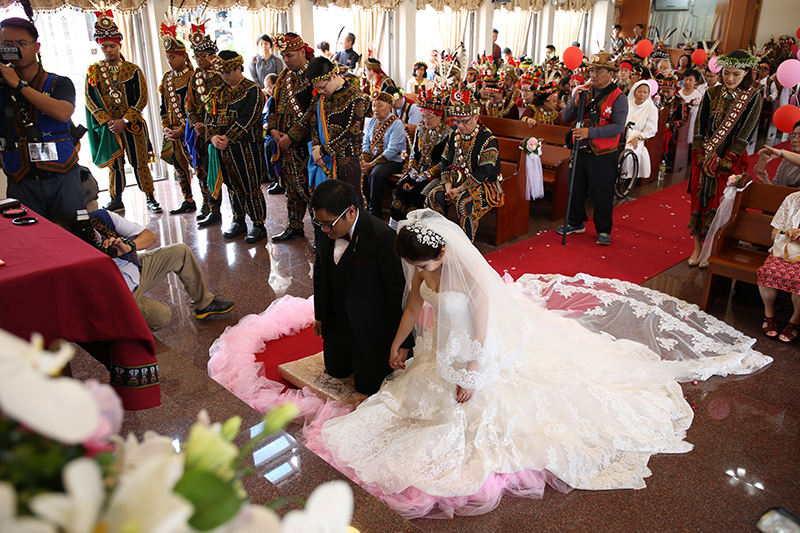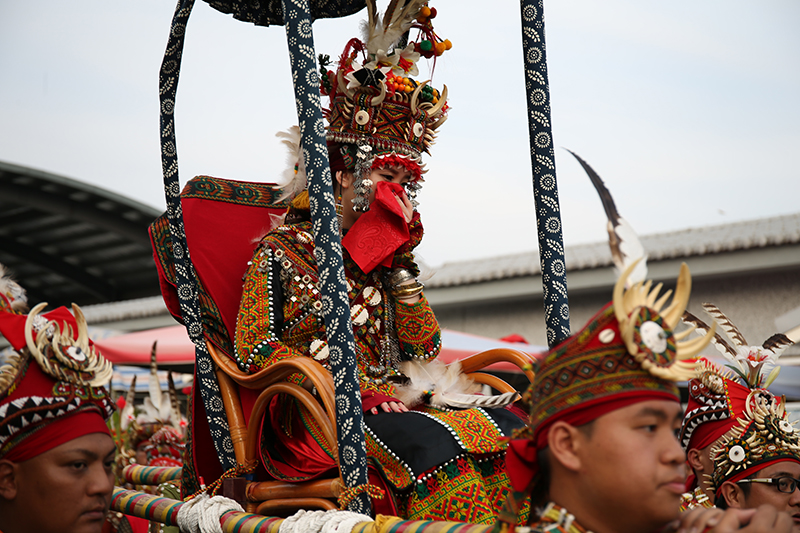Above: After the wedding, the Non-indigenous bride is officially considered as one of the Rukai community.
Elders guide the bride, dressed in traditional garbs, through the wedding ceremony.
The traditions of a people include the thoughts, culture, systems, and ways of doing things that have been passed down from generation to generation and have intangible constraining power and impact on society. For indigenous peoples, tradition is like a piece of life-saving driftwood that connects them to their roots as they face the brutal assaults of foreign cultures. However, tradition itself is constantly oscillating between “remaining the same” and “changing with the times”.
“I can't speak for other communities, but here in Adiri Village, we have never forgotten our traditional wedding rites.” Community leader Lavuras Abaliwsu said proudly as he talked about the preservation and popularity of traditional weddings in the community.

Community members flock to the wedding venue of Community leader Lavuras Abaliwsu’s son to give their blessings.
Let’s Talk About Love-
the Beginning of Romance
To ensure a happy and desired outcome, each community has very complicated and detailed rituals for different celebrations and purposes. For the Rukai, a wedding is a very important event. In fact, the Rukai have a set of customs that guide the young couple through the initial meeting, courtship, and eventual marriage in a courteous, steadfast, and meaningful manner. Lavuras Abaliwsu calls this process “the six stages of Rukai romance”.
The first stage is the “gift of courtship”. When a young man finds a girl he fancies, he will bring over plenty of fruit, millet cakes, and wild boar meat to the girl’s house on the morning of the annual millet festival. The girl’s parents will share the gifts with other community members at the square, and announce that their daughter is ready for courtship.
“After the announcement of courtship, the two will start to date.” Lavuras Abaliwsu explained with a smile. In the past, Rukai couples expressed their love in a very unique way. “The young man would come to the girl’s house with a group of friends and sit in the stone slab house. The girl, with her close friends, will sit next to the window. Both sides will trade songs back and forth until the break of dawn.” The couple cannot talk to each other, and can only express their feelings through their songs. Moreover, the girl has to sit sideways and lower her head. She cannot look directly at the boy to show demureness. Lavuras Abaliwsu recalled the times when he watched his aunts’ love song trading ceremonies as a boy. When his aunt tried to sneak a peek at her suitor, the elderders and parents present will immediately pinch her thigh.

After the bride leaves her home, the groom’s friends and family carries her in a sedan to the groom’s house. Community members give their blessings along the way.
From Engagement to Wedding
It's a Family and Community Affair
If the girl is interested, she will wear the garland from the suitor the next morning as a response. After confirming both sides are willing to enter a marriage, the families can move on to discussing betrothal gifts and start the engagement ceremony. Lavuras Abaliwsu added that a person may have many dates in their life, so before the wedding, they have to go to their ex-lover’s home and apologize. This is known as “rejected love”. Before Lavuras Abaliwsu got married, his family prepared a lot of gifts to bring to the princess that was promised to him since they were in their mothers’ wombs. Likewise, if the bride eventually marries someone else, she also has to send gifts to her ex-boyfriend and tearfully bid him goodbye.
After the engagement comes the wedding. The whole procedure is so complicated it requires a month to complete. “The wedding actually includes five major rituals. First the groom has to bring the bride to the culture square and give her and her family the betrothal gifts; then comes the ceremony in the church, which is followed by the reception. After the feast there is a dancing party, and finally the bride is carefully escorted to the groom’s house.” Lavuras Abaliwsu explained.
Nowadays, most of the complex rituals are simplified. For example, the love song trading ceremony is gone. Lavuras Abaliwsu also mentioned that the very last stage of the whole wedding, the “consummation of the marriage”, was abandoned many decades ago. “Only very few couples could complete that part. Since elders from both sides were present during this stage, there was basically zero privacy and it was simply impossible to complete this stage.”
The Responsibility of a Community Leader’s Family
is Never Put Down
Changes in traditions do not necessarily mean getting rid of them, sometimes the traditions just require slight modifications so that it is more suitable for current times. Raised in a community leader’s family, Lavuras Abaliwsu was expected to carry on the title and its responsibilities. He pointed out that a Rukai community leader does not lead a comfortable “royal life” as speculated by outsiders. “A community leader is not an emperor. He is not rich, nor does he have a harem of women. Our ancestors have taught our community leaders to be a leader and model for the village. We are only allowed to eat after the whole community is fed.”
Bearing the title of community leader does not mean you are above the people, it simply indicates you carry much responsibility. There is no monetary allowance, no awards, only honor; and in the past, community leaders didn’t even have the freedom to choose their own spouses. “Members of the community leader’s family had to marry a spouse of equal social status. So if there was a princess of similar age in another village, she would very likely be my bride.” When Lavuras Abaliwsu was a boy, community leaders still had to marry a bride of equal status. “I did not have the freedom to court other young ladies. I could only pine for them.”
For Lavuras Abaliwsu’s generation, marriages are ruled by blood and social class. However, since there are more inter-community marriages and changes in customs now, the rules are no longer strictly enforced and community leaders do not have to marry a spouse of the same social status anymore. “We don’t really care about bloodlines. What really matters is the sense of identity and dedication.” Lavuras Abaliwsu said solemnly when asked about the his family's thoughts on the shift, “The most important thing is that the leaders can carry on the spirit and core values of our Lily Blossom Culture and show that they are capable of shouldering responsibility.”

On the same day of the wedding, the Rukai groom will also send several betrothal gifts to the bride’s family to show his love and dedication to his bride.
Shouldering the Responsibility
and Getting Married in a Traditional Wedding
A traditional indigenous wedding is very different to traditional Non-indigenous weddings. The weight of a full traditional wedding costume is so heavy that even local community members have problems wearing them. And since the wedding of a village community leader is extremely important, the couple has to follow many detailed rules and customs. But Lavuras Abaliwsu was pleasantly surprised by his daughter-in-law, for she not only saw to everything personally, but tried her best to make everything perfect.
Following traditions, the couple first completed the wedding in a church. After the daughter-in-law officially joined the Rukai community, the formal betrothal gift ceremony began. To show his devotion to the bride, the groom prepared a number of betrothal gifts according to traditional customs, such as firewood and chestnut wine (which symbolize affection), a large iron pot (symbolizing plentiful food and good life), a clay pot exclusively for the community leader, and bunches of millet to symbolize harvests. There was also the essential whole pigs/pork. A group composed of the groom’s family and friends carries the betrothal gifts to the bride’s house, and then carried the bride in a sedan back to the village.
Back at the village, the bride put on a lily headdress and danced and celebrated with the entire community in the square. This was followed by the swinging ceremony which is only seen in Rukai communities. The swing was built by community members with traditional methods. The bride, in all her splendor, stepped onto the vine foothold, and after her knees were secured, began to swing. In the end, her groom carried her down with a steady hand. This not only displayed their strong love, but also showed off the groom’s physical strength. During the reception after the wedding, the newlyweds went from table to table to thank the community members for their blessings.
Seeing that his daughter-in-law completed the entire wedding according to traditional Rukai wedding customs, Lavuras Abaliwsu admitted he was very impressed, yet still slightly worried. “It's hard, they still have a lot ahead of them. The responsibility of a community leader’s family is a heavy burden.”

After becoming a Rukai bride, elders from the community leader’s family will put lilies in the bride’s headdress as a symbol of her purity.
The Lily that Symbolizes Purity
and Ethics Protects Village Beliefs and Values
Although some traditional customs have changed, there are still some elements the community insists on preserving. For example, the Rukai spirit of the lily is still visible in the Adiri Village community creed.
The lily is the flower of the Rukai people. Men are only allowed to wear lilies in their headpiece after they have hunted down six male boars with tusks and shared the meat with the community. The lily blossom symbolizes his courage and skills. As for women, they have to stay pure to win the right to wear lilies.
The community creed is not a set of legal regulations. It completely depends on the entire community’s faith and compliance to the culture to safeguard morals. But as modern society rapidly evolves, how can a small village avoid the strong tides of change and continue to preserve traditional virtues and culture?
“This is one of the issues that I, as a community leader, have to think about,” Lavuras Abaliwsu said calmly yet firmly, “we need to firmly protect our core values. I will safeguard the traditions of the lily culture and be the model and leader of our community." Blooming wild lilies can be seen all over Adiri Village, just like the happy marriages and households of community members which shine with abundant love.




